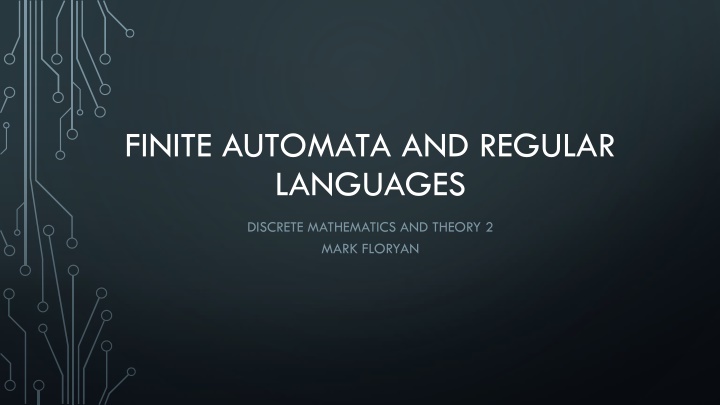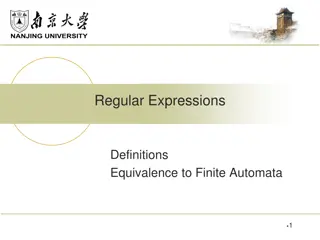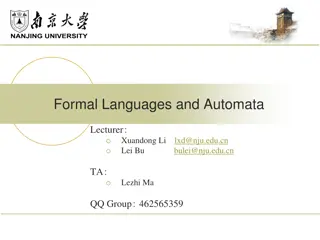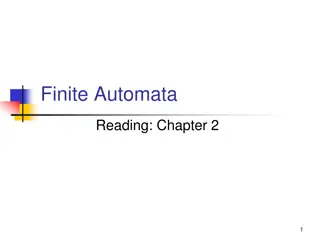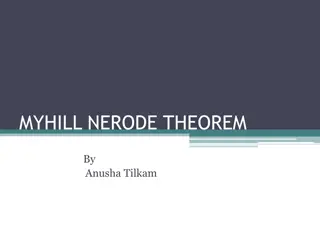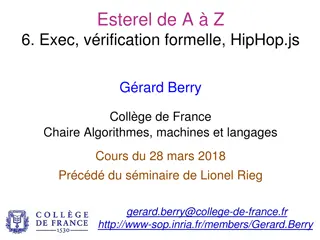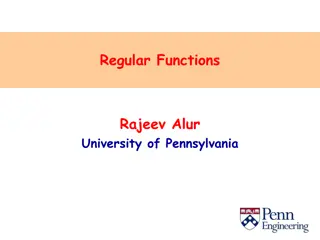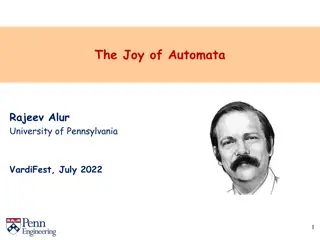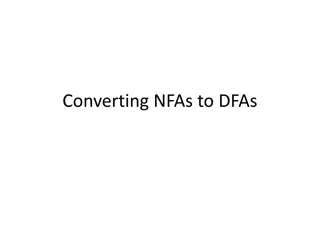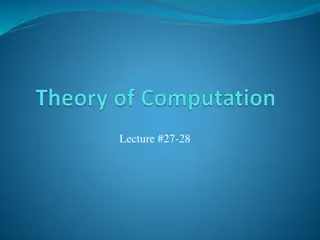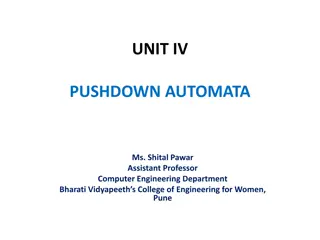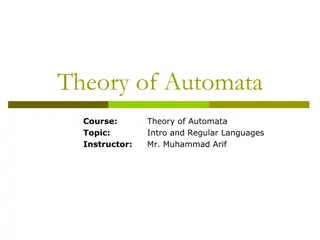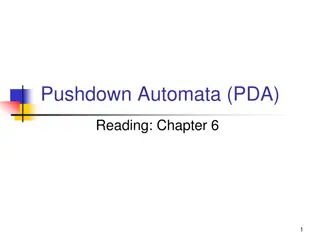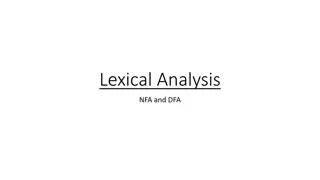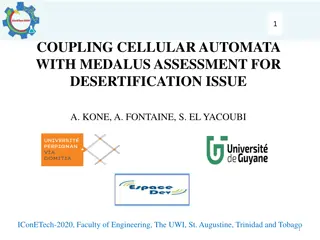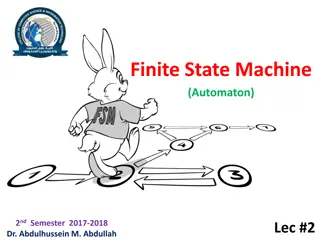FINITE AUTOMATA AND REGULAR LUNGUAGES
Delve into the fundamental concepts of finite automata and regular languages as part of discrete mathematics with Mark Floryan's comprehensive guide. This resource explores the theoretical foundations and practical applications, providing a solid understanding of these crucial topics. From basic principles to advanced techniques, this text is a valuable tool for students and professionals interested in computational theory and language theory.
Download Presentation

Please find below an Image/Link to download the presentation.
The content on the website is provided AS IS for your information and personal use only. It may not be sold, licensed, or shared on other websites without obtaining consent from the author.If you encounter any issues during the download, it is possible that the publisher has removed the file from their server.
You are allowed to download the files provided on this website for personal or commercial use, subject to the condition that they are used lawfully. All files are the property of their respective owners.
The content on the website is provided AS IS for your information and personal use only. It may not be sold, licensed, or shared on other websites without obtaining consent from the author.
E N D
Presentation Transcript
FINITE AUTOMATA AND REGULAR LANGUAGES DISCRETE MATHEMATICS AND THEORY 2 MARK FLORYAN
GOALS! 1. Quick definition of languages a different way to think about functions AND introduction to the Chomsky Hierarchy. 2. Our first model of computation, the finite automata!! How does it work? How do we prove things about what functions it can compute? Etc 3. Are there equivalent models / expressions that are equivalent to the finite automata? How do we identify functions that can NOT be computed by these?
PART 1: FUNCTIONS, LANGUAGES, AND THE CHOMSKY HIERARCHY
TYPES OF PROBLEMS Name XOR Decision Problem Are there an odd number of 1 s? Function Language ? has and odd number of 1s} ? ? ? = 0 number of 1s is even 1 number of 1s is ??? ? ? has more 1s than 0s} Majority Are there more 1s than 0s? ? ? = 0 more 0s than 1s 1 more 1s than 0s ? ? ?? ? ? ????????} Thing you want to compute Does it have have a property? ? ? = 1 ?? ?? ???? ??? ? ? ???????? Is1 Is the string exactly 1 ? ? ? = 1 ?? ? == 1 1} Is_infinite Is the length of the string infinite? ? ? = 0
CHOMSKY HIERARCHY Each language has a computational model that recognizes it A description of languages and their relationship to one another In this deck, we will see the regular languages and the machines that recognize them
PART 2: FINITE AUTOMATA AND REGULAR LANGUAGES
FINITE STATE MACHINES First model of computation that we will look at in detail. Features: Has a VERY limited amount of memory. What can we compute with such limited memory? What input / output does this machine support? Does this matter? Can we find at least one function that this machine CANNOT compute?
DETERMINISTIC FINITE AUTOMATA (DFA) Accepts Input as a string Example Input: AABCDAABCCC When one character of input is read, machine transitions to a new state B,C,D A,B,C,D S1* S4 A A One or more states are considered accepting states One state is the special start state A S2 S3 B,C,D B,C,D Machine has some number of states (4 in this example) in can be in. Machine is only in one state at a time. This is the ONLY variable / memory DFAs have
DETERMINISTIC FINITE AUTOMATA (DFA) Accepts Input as a string Example Input: AABCDAABCCC Let s step through the execution of this machine B,C,D A,B,C,D S1* S4 A A A S2 S3 B,C,D B,C,D
DETERMINISTIC FINITE AUTOMATA (DFA) Accepts Input as a string Example Input: AABCDAABCCC The formal definition of a deterministic finite state machine is: A finite automaton is a 5-tuple (?, ,?,?0,?) B,C,D A,B,C,D Where: ? is a finite set called the states S1* S4 is a finite set called the alphabet A A ?:? ? ? is the transition function A ?0 ? is the start state S2 S3 ? ? is a set of accept states (or final states) B,C,D B,C,D
ACTIVITY: DESIGN A STATE MACHINE Imaging an automatic sliding door at, say, a grocery store. Front Pad Front Pad
Mouse moves over button Hover State 1 ---------- Currently hovering ANOTHER EXAMPLE: HOW BUTTONS WORK Hover State 0 ---------- No hover Mouse moves away from button Hover state = 0 && Mouse button up State 1 ---------- Mouse went down beginning a click State 2 ---------- Mouse went up completing a click State 0 ---------- No click has begun Hover state = 1 && Mouse button down Hover state = 1 && Mouse button up 200ms passed, no double click started Register a single click Hover State = 0 && Mouse button up Register Double Click Hover state = 1 Mouse button down State 4 ---------- Mouse up completing double click State 3 ---------- Mouse back down, starting a double click Hover state = 1 Mouse button up
PRACTICE PROBLEM 1 List out the formal description (5-tuple) for this machine What set of strings does this machine recognize? 1 0 0 1 S3 S2 S1 0,1
PRACTICE PROBLEM 2 Design a DFA that accepts any binary string that contains 001 as a substring anywhere (possibly multiple times) in the string. The DFA should reject if the string does not contain a contiguous 001 anywhere in the string. Examples: 011110101011111 111110010101011 REJECT ACCEPT
FORMAL DEFINITION OF COMPUTATION Formal definition of computation on a DFA ? = (?, ,?,?0,?) on input string ? = ?1?2?3 ?? and each ?? M accepts the string w if a sequence of states ?0,?1,?2, ,?? ? exists such that: 1. ?0= ?0 2. ? ??,??+1 = ??+1 for ? = 0, ,? 1 3. ?? ?
MOTIVATING QUESTION Does adding a new feature / functionality to our machine / computational model increase the number of functions (or languages) it can recognize?
EXAMPLE: 2-DFA What does this machine do on input: 000100 Imagine a DFA with the following extra feature: 1 0 S4 S1 The machine works exactly as a DFA we have already described, except it can be in up to two states at once. 0 1 1 0 S5 S2 Notes: 2 start states Each state transitions after reading each symbol Machine accepts in either state is in final state at end 0 1 0, 1 0, 1 S6 S3 In general, what language does this machine recognize?
2-DFA VS. DFA? Which of the following do you think is true? Possible Theorem 1: A 2-DFA is equivalent in computational power as a traditional DFA In other words: For any language L, there exists a DFA that accepts it iff there exists a 2-DFA that accepts it (note the if and only if here) Possible Theorem 2: A 2-DFA has more computational power than a DFA In other words: There exists at least one language L that can be recognized by a 2-DFA but cannot be accepted by any DFA
2-DFA VS. DFA? Possible Theorem 1: A 2-DFA is equivalent in computational power as a traditional DFA In other words: For any language L, there exists a DFA that accepts it iff there exists a 2-DFA that accepts it (note the if and only if here) How do we prove this? Prove both directions of the claim: Suppose we think this one is true (spoiler: it is!) 1. If a DFA exists that accepts L, then a 2-DFA exists that accepts L (easy one) 2. If a 2-DFA exists that accepts L, then a DFA exists that accepts L (a little harder) Basic idea: If one type of machine accepts a language L, can you simulate that machine with the other type?
2-DFA VS. DFA? Possible Theorem 1: A 2-DFA is equivalent in computational power as a traditional DFA Consider direction 1 first: If a DFA exists that recognizes some language L, then a 2-DFA exists too! 0, 1 0 0 S4 S1 S1 1 1 Given a DFA that accepts an arbitrary language L (left), describe the process for turning this into an equivalent 2-DFA (right) 0 0 S2 S2 Add a dummy state that the 2-DFA will also be in at all. times, doesn t affect the language L that gets recognized 1 1 0, 1 0, 1 S3 S3
2-DFA VS. DFA? Possible Theorem 1: A 2-DFA is equivalent in computational power as a traditional DFA Consider direction 1 first: If a DFA exists that recognizes some language L, then a 2-DFA exists too! Construct a 2-DFA D as such: Consider an arbitrary DFA D that recognizes an arbitrary language L: ? = (? , ,? , ?0,??,?) Here is the formal version of this process ? = (?, ,?,?0,?) Such that: ? = ? ?? ? = ? (?? x ) ??} Prove this works: Because D fulfills all the requirements of a 2-DFA, and executes the exact same way D does (except for being in the dummy second state at all times). Thus, any string that D accepts will also be accepted by D
2-DFA VS. DFA? Possible Theorem 1: A 2-DFA is equivalent in computational power as a traditional DFA Consider direction 2 next: If a 2-DFA exists that recognizes some language L, then a DFA exists too! 0 1 0 0 0 S1, S6 1 S1, S5 S1, S4 S4 S1 1 1 0 1 0 Given a 2-DFA that accepts an arbitrary language L (left), describe the process for turning this into an equivalent DFA (right) 0 0 1 0 S2, S6 S2, S5 S2, S4 S5 S2 1 1 1 0 1 0, 1 0 0, 1 0 0, 1 S3, S4 S3, S6 S3, S5 S6 S3 1 1
One start state (combination of two start states in original DFA 2-DFA VS. DFA? Each state represents a combination of states the 2-DFA can be in 0 State is final if ONE of the two was final in the original DFA 1 0 0 0 S1, S6 1 S1, S5 S1, S4 S4 S1 1 1 0 1 0 0 0 S2, S6 S2, S5 S2, S4 1 0 S5 Transitions show how one symbol leads to a new combination of 2 states in original DFA S2 1 1 1 0 1 0, 1 0 0 S3, S4 S3, S6 S3, S5 0, 1 0, 1 S6 S3 1 1 Prove that it works: The new DFA will always accept if the original 2-DFA does because each state in the new DFA represents exactly one pair of states of the original 2-DFA. Thus, with a traditional DFA, we can simulate exactly what the 2-DFA would have done and accept if and only if the original 2-DFA accepts.
2-DFA VS. DFA? Possible Theorem 1: A 2-DFA is equivalent in computational power as a traditional DFA Consider direction 2 next: Here is the formal version of the process Consider an arbitrary 2-DFA D that recognizes an arbitrary language L: Construct a DFA D as such: ? = (? , ,? ,?0,1,? ) ? = (?, ,?, ?0,?1},?) Such that: ? = ??,? ??,?? ?} ? = (??,?,? ?? ,? ? , ??,? ?? ?, ??,? ?? ? ? = ??,? ?? ? ?? ?}
2-DFA VS. DFA? Possible Theorem 1: A 2-DFA is equivalent in computational power as a traditional DFA Thus, it is proven!!!!
NON-DETERMINISM Let us now look at a different, but similar functionality we can add to the DFA: Non-Determinism Non-Determinism: Is a feature of computational models that allows them to exist in multiple states at one time. The machine can be in any number of it s states simultaneously. Note that this will be an extension of the 2-DFA. Effectively, an n-DFA where the DFA has n states. The main difference being that an NFA does not HAVE to be in multiple states.
NON-DETERMINISM DEFINITION AND EXAMPLE A Non-Deterministic Finite Automaton (NFA) is a DFA than can be in multiple states at once. Formally: A non-deterministic finite automaton is a 5-tuple (?, ,?,?0,?) where: 0,1 0,1 1 0, ? 1 1. ? is a finite set of states 2. is a finite alphabet 3. ?: ? ? ? ?(?) is the transition function 4. ?0 ? is the start state 5. ? ? is the set of accept states S1 S2 S3 S4 ?(?) is the power set of Q ? is the alphabet plus epsilon (i.e., ?= ?})
NON-DETERMINISM DEFINITION AND EXAMPLE Note that S1 has two transitions for input character 1. This means if a 1 is read, two copies of the machine will split off. One transitions to S1 and the other transitions to S2 A Non-Deterministic Finite Automaton (NFA) is a DFA than can be in multiple states at once. Formally: A non-deterministic finite automaton is a 5-tuple (?, ,?,?0,?) where: 0,1 0,1 1 0, ? 1 1. ? is a finite set of states 2. is a finite alphabet 3. ?:(? ? ?) ?(?) is the transition function 4. ?0 ? is the start state 5. ? ? is the set of accept states S1 S2 S3 S4 ? is called an empty transition or an epsilon transition. Machine splits into multiple copies of itself (is in multiple states at once) and the copy transitions to the new state without reading input.
NON-DETERMINISM DEFINITION AND EXAMPLE 0,1 0,1 1 0, ? 1 S1 S2 S3 S4 Let s run this machine on some sample input. In general, what language does this machine recognize? Inputs to try: 0000 1101 11 10 10001 Answer: Strings that contain 11 or 101 somewhere in them.
NON-DETERMINISM EXAMPLE Practice: Develop an NFA that accepts the following language: Let A be the language consisting of all strings over 0,1 containing a 1 in the third position from the end (e.g., 000100 is in A but 0011 is not).
NON-DETERMINISM EXAMPLE Practice: Develop an NFA that accepts the following language: Let A be the language consisting of all strings over 0,1 containing a 1 in the third position from the end (e.g., 000100 is in A but 0011 is not). 0,1 0,1 0,1 1 S1 S2 S3 S4
NON-DETERMINISM EXAMPLE Practice: Develop an NFA that accepts the following language: Let A be the language consisting of all strings over 0,1 containing a 1 in the third position from the end (e.g., 000100 is in A but 0011 is not). FYI: Here is a DFA that accepts A. Oftentimes, using an NFA is much simpler
NON-DETERMINISM EXAMPLE Practice: Develop an NFA that accepts the following language: Let A be the language consisting of all strings over 0,1 ending in 101 or ending in 010
EQUIVALENCE OF NFA AND DFA? Which of the following do you think is true? Possible Theorem 1: An NFA is equivalent in computational power to a DFA In other words: For any language L, there exists a DFA that accepts it iff there exists an NFA that accepts it (note the if and only if here) Possible Theorem 2: An NFA has more computational power than a DFA In other words: There exists at least one language L that can be recognized by an NFA but cannot be accepted by any DFA
NFA VS. DFA? Possible Theorem 1: An NFA is equivalent in computational power to a DFA In other words: For any language L, there exists a DFA that accepts it iff there exists an NFA that accepts it (note the if and only if here) How do we prove this? Prove both directions of the claim: Suppose we think this one is true (spoiler: it is!) 1. If a DFA exists that accepts L, then an NFA exists that accepts L (easy one) 2. If an NFA exists that accepts L, then a DFA exists that accepts L (harder) Basic idea: If one type of machine accepts a language L, can you simulate that machine with the other type? It is the same (similar) proof as the 2-DFA example!!!
NFA VS. DFA? Possible Theorem 1: An NFA is equivalent in computational power to a DFA Consider direction 1 first: If a DFA exists that recognizes some language L, then an NFA exists too! 0 0 Trivial, a DFA is a valid NFA by definition, so don t actually need to change anything!! S1 S1 1 1 Given a DFA that accepts an arbitrary language L (left), describe the process for turning this into an equivalent NFA (right) 0 0 S2 S2 1 1 0, 1 0, 1 S3 S3
NFA VS. DFA? Possible Theorem 1: An NFA is equivalent in computational power to a DFA Consider direction 2 next: If an NFA exists that recognizes some language L, then a DFA exists that also accepts L! Given an NFA that accepts an arbitrary language L (left), describe the process for turning this into an equivalent DFA (right) States are every possible subset of states in the original NFA. When character is read from input, we transition to a new subset of states the NFA was in
NFA VS. DFA? Possible Theorem 1: An NFA is equivalent in computational power to a DFA Consider direction 2 next: If an NFA exists that recognizes some language L, then a DFA exists that also accepts L! Given an NFA that accepts an arbitrary language L (left), describe the process for turning this into an equivalent DFA (right) Some state combinations from previous slide are impossible (have no incoming edges), so they can be removed. This is the simpler version
NFA VS. DFA? Possible Theorem 1: An NFA is equivalent in computational power to a DFA Consider direction 2 next: Here is the formal version of the process Consider an arbitrary NFA N that recognizes an arbitrary language L: Construct a DFA D as such: ? = (? , ,? ,?0 ,? ) ? = (?, ,?,?0,?) Such that: ? = ?(?) ? = ? ? ,? ? ?,? ? ? ?(? ?,? )} ?0 ? = ? ? ? ? ? ?} = ?( ?0) What is E() here? Given a set of states R, let E(R) be the set of states that we can reach by traveling along epsilon transitions only, including the original states in the return value.
NFA VS. DFA? Theorem: An NFA is equivalent in computational power to a DFA Thus, it is proven!!!!
NON-DETERMINISM SUMMARY What did we learn in this section: 1. An NFA is a different type of machine that extends the functionality of a DFA 2. NFAs are often more convenient for recognizing languages because of the parallelism 3. NFAs and DFAs are equivalent in computational power 4. Do we know how to build an NFA in the real world? Kind of
MOTIVATING QUESTIONS Ok, we have NFAs and DFAs (and they are equivalent in computational power). What is the exact set of languages that these machines can recognize? Can we find at least one language that NFAs and DFAs cannot recognize (spoiler: yes)? How do we find one?
DEFINITION: REGULAR LANGUAGE A language is called a regular language if there exists some DFA that recognizes it and by equivalence, there exists an NFA that recognizes it too! This definition is a bit tautological right? Don t worry, it is a good definition for now and we will analyze what falls into this category and what doesn t soon.
PROPERTIES OF REGULAR LANGUAGES A language is called a regular language if there exists some DFA that recognizes it We are interested in the following (potential) properties of Regular Languages: Let A and B be languages, we define the regular operations as follows: ? ? = ? ? ? ? ?} Union: ? ? = ?? ? ? ? ?} Concatenation: ? = ?1?2 ??? 0 ? ?? ?} Star:
